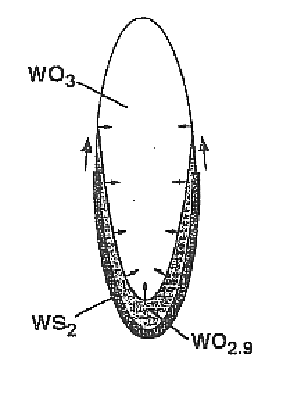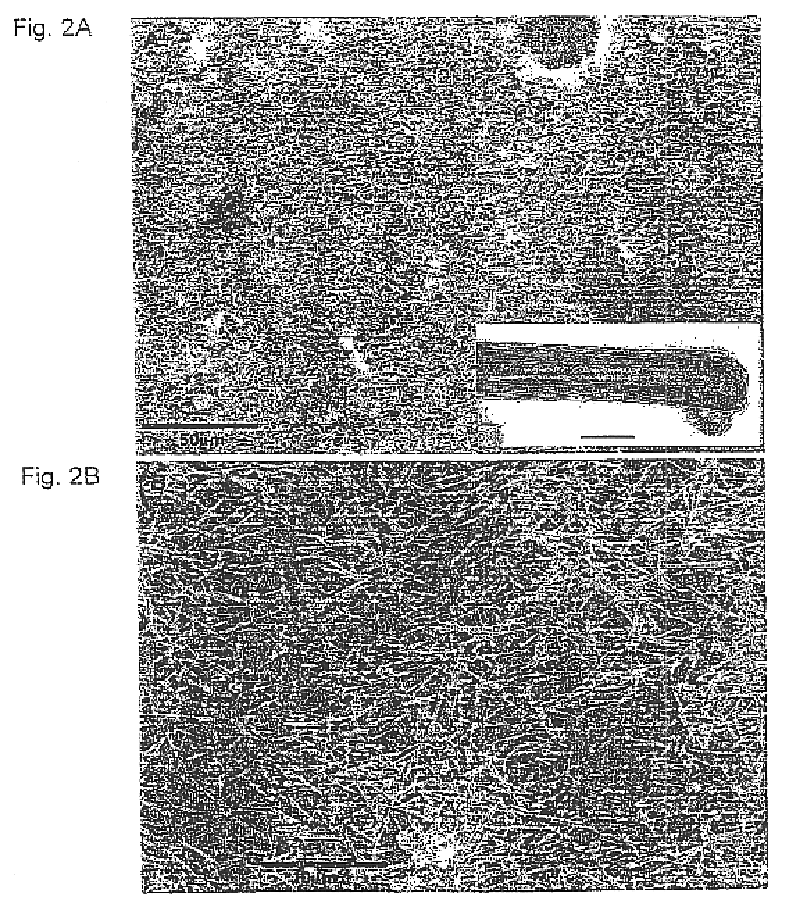Bulk synthesis of long nanotubes of transition metal chalcogenides
a technology nanotubes, which is applied in the field of bulk synthesis of long nanotubes of transition metal chalcogenides, can solve the problems of poor reproducibility of nanotube growth, and none of the methods described recently for the synthesis of wssub>2 /sub>and mossub>2 /sub>nanotubes mentioned above permit bulk synthesis
- Summary
- Abstract
- Description
- Claims
- Application Information
AI Technical Summary
Problems solved by technology
Method used
Image
Examples
example 1
Synthesis of WS2 Nanotubes (Experiment A)
1a. Synthesis of Precursor Nanoparticles of WO2.9
In the first step (stage I), a powder consisting of asymmetric oxide nanoparticles of ca. 10-30 nm in diameter and a length of 40-300 nm is produced in a high vacuum evaporator. After pumping to ˜10−4 Torr, water vapor from an external reservoir is introduced through a needle valve while pumping with a rotary vane pump so that the pressure can be regulated to any desired value up to the vapor pressure of water at room temperature, ca. 20 Torr. A tungsten filament is heated to 1600±20° C. The water molecules react with the hot tungsten filament and produce (WO3)n clusters which condense on the walls of the bell jar or, alternatively, onto a water-cooled copper surface. If the water vapor pressure is maintained in the pressure range 8-12 Torr, crystalline oxide nanoparticles with an asymmetric shape are produced. A transmission electron microscope (TEM) image of a typical batch of nanoparticles ...
example 2
Synthesis of WS2 Nanotubes (Experiment B)
2a. Experimental Section
(i) Synthesis of the WO3−x Particles
Tungsten suboxide particles (WO3−x) were produced by heating a tungsten filament (model ME11 from the R. D. Mathis company) in the presence of water vapor inside a vacuum chamber, by the following procedure: once the vacuum in the bell-jar had reached a value of 10−4 Torr, the filament was heated for a few minutes in order to remove the superficial oxide layer. Water vapor was then allowed to diffuse into the vacuum chamber through an inlet, until the desired pressure was reached. The filament was heated to around 1600±20° C., while the pressure in the chamber was maintained constant during the evaporation process (a few Torr). After a few minutes of evaporation, a blue powder condensed on the bell-jar walls. The accrued powder consisted of needle-like WO3−x particles (ca. 50 nm in length and 15 nm in diameter) under a specific water vapor pressure.
NiCl2 or CoCl2 (2×10−3 M) salts wer...
example 3
Growth of the WS2 Nanotubes in the Two-Step Process
From the present measurements, one can visualize the growth process of the encapsulated nanowhisker as depicted in FIG. 8. At the first instant of the reaction (FIG. 8A), the asymmetric tungsten oxide nanoparticle reacts with H2S and forms a protective tungsten disulfide monomolecular layer, prohibiting coalescence of this nanoparticle with neighboring oxide nanoparticles. Simultaneous condensation of (WO3)n or (WO3−x.H2O)n clusters on the nanowhisker tip and reduction by hydrogen gas leads to growth of the sulfide-coated oxide nanowhisker. This process is schematically illustrated in FIG. 8B. Note that during the gradual reduction of the oxide core, the CS planes in the oxide phase rearrange and approach each other until a stable oxide phase W3O8 is reached (Iguchi, 1978). In FIG. 8C, [010} is the growth axis of the W3O8 whiskers. This phase provides a sufficiently open structure for the sulfidization to proceed until the entire ox...
PUM
 Login to View More
Login to View More Abstract
Description
Claims
Application Information
 Login to View More
Login to View More - R&D
- Intellectual Property
- Life Sciences
- Materials
- Tech Scout
- Unparalleled Data Quality
- Higher Quality Content
- 60% Fewer Hallucinations
Browse by: Latest US Patents, China's latest patents, Technical Efficacy Thesaurus, Application Domain, Technology Topic, Popular Technical Reports.
© 2025 PatSnap. All rights reserved.Legal|Privacy policy|Modern Slavery Act Transparency Statement|Sitemap|About US| Contact US: help@patsnap.com



